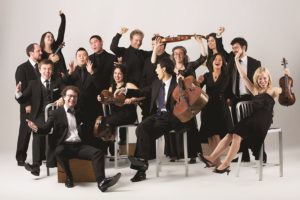A Far Cry may be one of the most democratic ensembles out there. This Boston-based orchestra is “self-conducted,” meaning that the players, who call themselves “criers,” take turns leading the group and make collective decisions on interpretation and repertoire.
The group is relatively young, founded in 2007, but it has already made a name for itself, having received two Grammy nominations. There is also a Cape connection: Jae Cosmos Lee, concertmaster of the Cape Symphony, plays in the ensemble.

Last Saturday, “The Shape of Joy,” the third concert in their online season, was streamed. This prerecorded performance consisted of chamber music, played with masks worn and social distancing, in the beautiful Boston Athenaeum. You can watch it anytime on demand, at afarcry.org, with various streaming options from $8 and up.
What’s streamed isn’t just a concert. There’s also an introduction by curator and violinist Megumi Stohs Lewis, interspersed interviews with the composers, and a live chat. Almost everything an audience needs to know is already there, making a reviewer’s job tougher.
In her introduction, Lewis says that the concept for the concert was to evoke the feeling that the criers will have when they are able to play music, unencumbered, again. That is: pure joy.
But in music, as in life, joy is rarely uncomplicated. It is almost always tinged with something else. The pieces on the program are joyful, to be sure, but they are also profound.
First on the program was “Breathing Sunlight,” a duet for violin and cello by Akshaya Avril Tucker. It is inspired by Indian classical music.
Robyn Bollinger plays the initial violin melody beautifully. It is tempting to call her sound plaintive, not joyful, but is that coming from a Western sensibility? After all, the piece has a variety of global influences. Perhaps contemplative is a better word.
The violin oscillates between the same note played on adjacent strings, which becomes a motif in the piece, and cellist Rafael Popper-Keizer joins in with plucked notes.
“Breathing Sunlight” is filled with harmonics and dissonances between neighborly notes. There are slides that approach each other but don’t quite meet. At times, they almost sound like a plane taking off.
The middle of the piece is faster and more energetic. But right after it reaches its peak, it returns to the contemplative mood of the beginning. Tucker says in the program notes that the piece, dedicated to her grandfather, is “about moments spent with those who will leave us soon.”
Next is “Limestone & Felt,” a duet for cello and viola by Caroline Shaw, inspired by the soft and hard surfaces of limestone churches. It begins with Bartók pizzicatos, which are notes plucked so hard, they produce a snapping sound.
Violist Jason Fischer and cellist Rafael Popper-Keizer are perfectly in sync. Their concentration is so intense that they often don’t look up. But the communication is still there. The musicians also slap their instruments, for a percussive sound.
The bowed section of the piece uses a lot of warm open strings. If you close your eyes, it sounds almost like a string quartet, even though there are only two players.
The piece is perfect for the Athenaeum space. At the end, Fischer plays a series of furious pizzicato notes. They sound like someone trying to get in the last words in an argument. They end abruptly, echo, and fade.
The last piece on the program, Mozart’s String Quintet No. 1 in B-Flat Major, was composed when he was only 17, in 1773. It was the first of his six viola quintets — that is, works for string quartet plus a second viola.
Surprisingly, it is the least interesting piece on the program, though well played. It was also the most carefree and overtly joyful. In the first movement, cellist Loewi Lin introduces brief moments of tension and darkness, but these resolve quickly. Violinist Jesse Irons’s silvery tone was especially beautiful in the second movement.
The greatest joy from the program, however, was to hear two pieces by young, female composers, who not only speak with insight and authority in their interviews, but whose work stands up to none other than Mozart.
On Sunday, Nov. 29, at 7 p.m., violinist Jae Cosmos Lee and violist Jason Fisher will be sharing their favorite A Far Cry recordings in “Thanksgiving With a Far Cry,” a program on WCRB 99.5.



